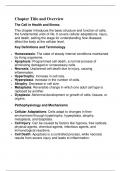Chapter Title and Overview
The Cell in Health and Illness
This chapter introduces the basic structure and function of cells,
the fundamental units of life. It covers cellular adaptations, injury,
and death, setting the stage for understanding how diseases
affect the body at the cellular level.
Key Definitions and Terminology
Homeostasis: The state of steady internal conditions maintained
by living organisms.
Apoptosis: Programmed cell death, a normal process of
eliminating damaged or unnecessary cells.
Necrosis: Unplanned cell death due to injury, causing
inflammation.
Hypertrophy: Increase in cell size.
Hyperplasia: Increase in the number of cells.
Atrophy: Decrease in cell size.
Metaplasia: Reversible change in which one adult cell type is
replaced by another.
Dysplasia: Abnormal development or growth of cells, tissues, or
organs.
Pathophysiology and Mechanisms
Cellular Adaptations: Cells adapt to changes in their
environment through hypertrophy, hyperplasia, atrophy,
metaplasia, and dysplasia.
Cell Injury: Can be caused by factors like hypoxia, free radicals,
physical agents, chemical agents, infectious agents, and
immunological reactions.
Cell Death: Apoptosis is a controlled process, while necrosis
results from severe injury and leads to inflammation.
, Risk Factors and Epidemiology
Genetic Factors: Certain genetic mutations can predispose
individuals to cellular dysfunction.
Environmental Factors: Exposure to toxins, radiation, and
infectious agents can cause cellular injury.
Lifestyle Factors: Poor nutrition, lack of exercise, and smoking
can contribute to cellular damage.
Clinical Manifestations
Symptoms of Cellular Injury: Swelling, loss of function, and
pain.
Signs of Cellular Death: Tissue necrosis, inflammation, and loss
of tissue function.
Diagnostic Procedures
Biopsy: Examination of tissue samples to identify cellular
abnormalities.
Imaging: Techniques like MRI and CT scans to visualize internal
structures.
Blood Tests: To detect markers of cell injury or death.
Complications and Prognosis
Complications: Chronic inflammation, fibrosis, and organ
dysfunction.
Prognosis: Depends on the extent of cell injury and the body’s
ability to repair and regenerate.
Treatment and Management
Primary Treatments: Addressing the underlying cause of cell
injury, such as removing toxins or treating infections.
Emerging Therapies: Stem cell therapy and regenerative
medicine to repair damaged tissues.
, Case Studies and Clinical Scenarios
Case Study Example: A patient with chronic obstructive
pulmonary disease (COPD) showing cellular adaptations like
hypertrophy and hyperplasia in the respiratory tract.
Clinical Scenario: A patient exposed to a chemical toxin
presenting with symptoms of cellular injury and necrosis.
Practice Questions with Rationales
1. Multiple Choice Question: What is the primary difference
between apoptosis and necrosis?
o A. Apoptosis is a controlled process, while necrosis is
unplanned.
o B. Apoptosis causes inflammation, while necrosis does not.
o C. Necrosis is a normal process, while apoptosis is not.
o D. Necrosis occurs in healthy cells, while apoptosis occurs
in damaged cells.
o Rationale: The correct answer is A. Apoptosis is a controlled,
programmed cell death process, whereas necrosis is unplanned
and often results from injury, causing inflammation.
2. Short Answer Question: Explain how hypertrophy and
hyperplasia differ in terms of cellular adaptation.
o Rationale: Hypertrophy refers to an increase in cell size, often in
response to increased workload, while hyperplasia refers to an
increase in the number of cells, typically due to a stimulus that
promotes cell division.
Chapter Title and Overview
Inflammation and Healing
This chapter explores the mechanisms of inflammation, the
body’s immediate response to injury, and the subsequent healing
processes. It covers the types of inflammation, the cellular and
molecular events involved, and the factors that influence healing.
Key Definitions and Terminology
, Inflammation: The body’s protective response to injury or
infection, characterized by redness, heat, swelling, and pain.
Acute Inflammation: A short-term response to injury, involving
the rapid influx of immune cells.
Chronic Inflammation: A prolonged inflammatory response that
can lead to tissue damage.
Granuloma: A small area of inflammation due to infection or
foreign substances.
Fibrosis: The thickening and scarring of connective tissue,
usually as a result of chronic inflammation.
Regeneration: The process of renewal, restoration, and growth of
tissues.
Repair: The replacement of damaged tissue with scar tissue.
Pathophysiology and Mechanisms
Acute Inflammation: Triggered by infection or injury, leading to
the release of inflammatory mediators like histamines and
cytokines. This results in vasodilation, increased vascular
permeability, and the migration of immune cells to the site of
injury.
Chronic Inflammation: Occurs when the acute response fails to
eliminate the cause of injury, leading to ongoing tissue damage
and repair. This can result in conditions like rheumatoid arthritis
and chronic obstructive pulmonary disease (COPD).
Healing: Involves two main processes: regeneration and repair.
Regeneration restores normal tissue structure, while repair
involves the formation of scar tissue.
Risk Factors and Epidemiology
Genetic Factors: Certain genetic predispositions can affect the
inflammatory response.
Environmental Factors: Exposure to pollutants, allergens, and
infectious agents can trigger inflammation.





